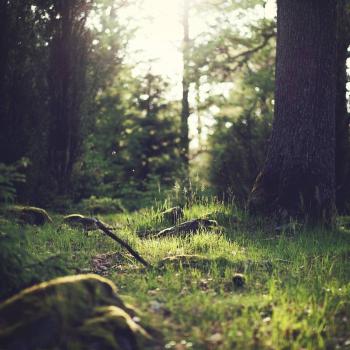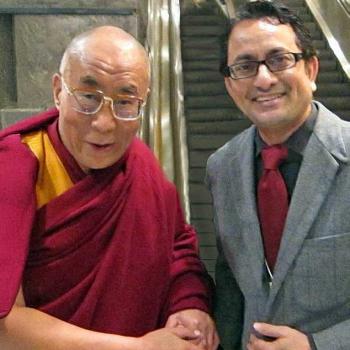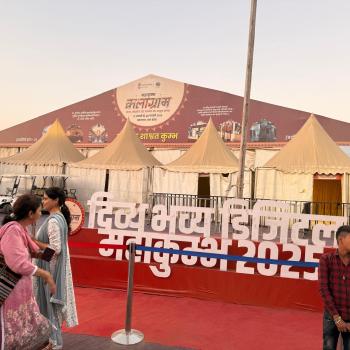The history of the modern and post-modern Religio Romana lends insight to the future of this ancient tradition. Past attempts to revive and reconstruct a modern version of the Religio Romana have generally begun with an organizational structure at the top, establishing priesthoods in some instances, before establishing communities of worshippers. That is, they began with a focus on the organizational structures of the developed state religion of imperial Rome of the Augustan Restoration. They then sought a state on which to place their hopes that would adopt the Religio Romana as its organized state religion, as Reghini and Evola had toward fascist Italy of the 1920s, or else to create a quasi-state or "micronation" as Bradford and Bloch attempted with Nova Roma in 1998.
In these early days of 1998 to 2001, the Religio Romana was involved in seeking legal recognition in the United States. It first came in a child custody case in Texas where the court accept the Religio Romana as an authentic "religious tradition," and later in the courts of two other states on similar grounds. By 2008 it was recognized a religious tradition by the U.S. military and federal government. While such instances were encouraging, they still represented state authorities deciding matters from above in regard to the development of the modern practice of the Religio Romana.
Greater success has resulted instead when individuals formed into local communities of worshippers. This has been the story of the Temple Religio Romana that formed in the Los Angeles area in 2003. It was the first organization of the Religio Romana to incorporate in the United States. That same year Nova Roma incorporated as an educational and fraternal cultural association. With the assistance of Antonia of the Temple Religio Romana and the advice of M. Horatius of the Societas Via Romana, the Clarian Temple of Religio Terranova next incorporated in the Philadelphia area. Both of these temples, on either coast of the United States, formed around core groups of around thirty people each. Smaller associations like the Sacred Grove of Egeria at Chapel Hill, North Carolina, and the Temple of Neptune in Georgia have yet to build communities with which to incorporate a stable organization. In 2006, Gentilitas was able to incorporate as a religious association by combining small local groups and families across Italy into one organization, and then each local group began to grow further.
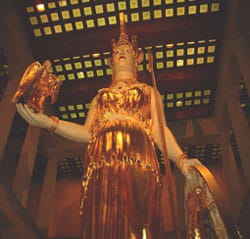 Organizations like Nova Roma and the Societas Via Romana have allowed cultores Deorum from distant places to meet one another. Nova Roma hosted its first European Conventus 2002 in Tongeren, Belgium, with the founders of the Societas Via Romana attending. The European conventions have since attracted people from all over the world to attend in Bologna, Segovia, Rome, Hadrian's Wall, Baiae Herculane, and again in Rome this year. A convention was also held in 2009 at the Parthenon in Nashville, TN (right) and one is planned later this autumn in South Carolina. These larger events generate more energy and stronger social bonds within the communities of cultores Deorum and between communities, allowing the development of more stable temple communities.
Organizations like Nova Roma and the Societas Via Romana have allowed cultores Deorum from distant places to meet one another. Nova Roma hosted its first European Conventus 2002 in Tongeren, Belgium, with the founders of the Societas Via Romana attending. The European conventions have since attracted people from all over the world to attend in Bologna, Segovia, Rome, Hadrian's Wall, Baiae Herculane, and again in Rome this year. A convention was also held in 2009 at the Parthenon in Nashville, TN (right) and one is planned later this autumn in South Carolina. These larger events generate more energy and stronger social bonds within the communities of cultores Deorum and between communities, allowing the development of more stable temple communities.
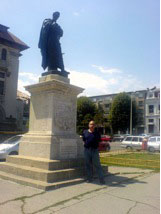 From my personal experience of attending the Conventus VI in Romania, it was a thrill to visit so many Roman sites -- Trajan's Bridge and the Roman fort at Dobreta, the Roman city of Ulpia Trajani with its ruins of Roman temples, the Iron Gates, the mausoleum at Trophaeum Trajani, all of the museums, the picturesque Carpathian Mountains and the Black Sea. Unforgettable was to be in the city of Tomis on the 2000th anniversary of Ovid's exile to that distant outpost of the Roman Empire, to stand in the shadow of his statue in Plaza Ovid, for one old Roman spirit to connect with the spirit of a more ancient Roman. No less uplifting was to be with fellow cultores from so many countries, joining together in rituals to offer common worship for our Gods and Goddesses in public. Very spiritual for me personally was to purify myself for ritual in the River Ister, to spiritually meet with so many generations of Roman cultores Deorum who had visited the Danube frontier of the Roman Empire in the same way before the Gods.
From my personal experience of attending the Conventus VI in Romania, it was a thrill to visit so many Roman sites -- Trajan's Bridge and the Roman fort at Dobreta, the Roman city of Ulpia Trajani with its ruins of Roman temples, the Iron Gates, the mausoleum at Trophaeum Trajani, all of the museums, the picturesque Carpathian Mountains and the Black Sea. Unforgettable was to be in the city of Tomis on the 2000th anniversary of Ovid's exile to that distant outpost of the Roman Empire, to stand in the shadow of his statue in Plaza Ovid, for one old Roman spirit to connect with the spirit of a more ancient Roman. No less uplifting was to be with fellow cultores from so many countries, joining together in rituals to offer common worship for our Gods and Goddesses in public. Very spiritual for me personally was to purify myself for ritual in the River Ister, to spiritually meet with so many generations of Roman cultores Deorum who had visited the Danube frontier of the Roman Empire in the same way before the Gods.
Currently we are seeing cultores Deorum and Gentiles Romani bringing individual practitioners and families together into temple communities, following the examples of the Temple Religio Romana and the Clarion Temple. This is a movement away from internet-based organizations to local communities that gather at a dedicated shrine (templum)for common worship. In Eastern Europe the plan takes us one step further in that they are building neighborhoods of cultores Deorum living in close proximity, working and worshipping together.

